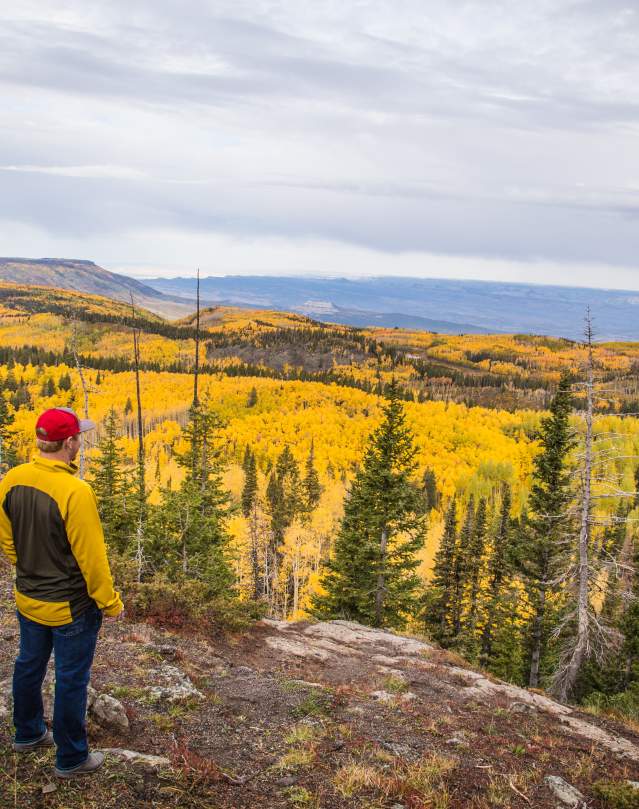The Wall Street Journal described Grand Junction as an emerging destination with diverse offerings. Geologically, the area is two-fifths of the state west of the Continental Divide, culturally extending further to Utah's landscape. The area features high desert landscapes, canyons, forests, orchards, and old mining towns. A rise in tourism and young transplants has revitalized the region. Outdoor amenities like mountain bike trails, via ferratas, river sports, and hiking are complemented by new restaurants and unique lodging. Grand Junction, a major hub, offers a mix of historic charm and modern flair, with a lively culinary scene. Palisade, known for fruit orchards and vineyards, is a side trip option. Nearby attractions include Dinosaur National Monument, Colorado National Monument, McInnis Canyons National Conservation Area, and Black Canyon of the Gunnison National Park's North Rim road.
Brigid Mander, Freelance Journalist:
"For most people, a Colorado holiday is anchored by images of Front Range cities, snowcapped Rocky Mountains and scenic roads leading directly to glitzy, refined alpine towns. But that glossy, well-honed visitor experience is only a narrow slice of the state.
For those in search of old-school mountain adventures and local color, the long overlooked western third of the state—often called the Western Slope—is an up-and-coming destination with diverse and increasingly sophisticated offerings.
In geology speak, the Western Slope refers to the two-fifths of the state west of the Continental Divide (the divide separating the Atlantic and Pacific watersheds). Culturally, however, the Western Slope begins farther west, where the landscape opens up onto the Colorado Plateau and slants down to Utah’s arid expanse. From Colorado’s northwest corner, a wide open, high desert landscape is home to pinyon forests and sagebrush, mesmerizing canyons with colorful rock formations, verdant farms, orchards and pasturelands. To the south, green, vibrant river basins give way to the Uncompahgre Plateau, the towering San Juan Range and a distinctly southwestern aura. Amid all this natural beauty, a smattering of old mining and oil-and-gas boom-bust towns dot the landscape and offer visitors a refreshing mix of charm and grit.
Over the past 10 years, a rise in tourism has coincided with young, cosmopolitan transplants relocating from crowded or more expensive areas, revitalizing the area. Outdoor amenities such as mountain-bike trails, via ferratas (roped-in mountain-climbing routes aided by iron rungs and bridges), river sports, hiking, climbing and protected landscapes are complemented by sophisticated new restaurants, entrepreneurs and unique lodging.
From the northwestern corner of the state to the southwestern corner, here is a list of spots worth visiting.
Start in Grand Junction
Fly into the city of Grand Junction, which is named for its place at the confluence of the Colorado (formerly the Grand) and Gunnison Rivers. A major agricultural hub for the state, it may have a gritty vibe on the outskirts, but the core is historic charm with a modern flair. Old buildings house breweries, eateries boast wine lists from local producers, and meticulous coffee shops like Kiln offer sophisticated brews. Browse art galleries, boutiques and public art on Main Street, and a tasting tour of the city’s lively culinary scene is a must. Taco Party, a bustling, delightfully hip spot is one example, featuring cactus dishes and a margarita list. Grand Junction also is, unsurprisingly, a hot spot for river sports, from multiday guided raft trips to paddleboard lessons.
For a side trip, journey about 10 miles east on I-70 to Palisade, a small town full of outdoorsy types. In summer, it brims with lush fruit orchards, flowers and vineyards under a border of fluted cliffs named The Books. Mildly sporty types can rent cruiser bikes and tour vineyards such as Colterris and Restoration; adrenaline seekers should head to the legendary mountain bike trails around Fruita, about 20 minutes west. Stake a temporary claim at Spoke and Vine, a renovated motel with a chic modern style for hikers, cyclists and sippers.
While in the vicinity, visit Dinosaur National Monument, a remote, lightly trafficked and spectacular federal monument straddling the northern Colorado-Utah border. Protected in 1915 by President Woodrow Wilson as a national treasure, it’s doable in a day from Grand Junction or Palisade with a two-hour-each-way drive across the beautiful Douglas Pass. Aim for the entrance just over the Utah border and visit Quarry Hall, a cliff face containing one of the most ecologically complete assemblages of Late Jurassic dinosaurs known in the world, according to the National Park Service. Hike among rainbow-colored geologic formations, petroglyphs and more fossils before heading back.
After Dinosaur, a number of other lesser-known protected federal lands are easy to access from Grand Junction. The Colorado National Monument is the most well-known. A vast desert plateau eroded into monoliths, red rock canyon walls with green pinyon pine forests and sagebrush, it’s also home to wildlife such as mule deer, big horn sheep and eagles. To see the West’s iconic red sandstone arches but without the tourists who throng Arches National Park, head just northwest of the Colorado National Monument to McInnis Canyons National Conservation Area. Here, Rattlesnake Canyon contains the second-largest concentration of natural arches in the world.
For more natural beauty, visit the North Rim road of Black Canyon of the Gunnison National Park, just over an hour south from Grand Junction on the way to the historic mining town of Ouray. A deep river canyon exposes layers of rocks hundreds of millions of years old, all above a rushing river deep below the rim.
Ouray to Durango
Spend a day or two in the charming but still a bit rough-around-the-edges outpost of civilization in Ouray, which is about 96 miles south of Grand Junction. Take a break from looking at rocks and get on the rock via the Ouray Via Ferrata with guides from San Juan Mountain Guides or from Mountain Trip. Post up at the Western, an 1891 boardinghouse newly renovated into a stylish hotel. Before heading to Durango on U.S. Highway 550, also known as the Million Dollar Highway (so named as it purportedly cost a million dollars a mile to construct), grab picnic lunch supplies at Ouray Meat and Cheese Market.
Highway 550 climbs to the summit of Red Mountain Pass and breathtaking vistas are more or less nonstop. But don’t take your eyes off the road, since it lacks guardrails. Safer scenic pullouts are built over cascading creeks, waterfalls and sweeping vistas. Near the summit, stretch your legs with your picnic supplies and a moderate three-mile round-trip hike to the base of Red Mountain 3 (there’s a dirt road you can drive, as well) from Black Bear Pass trailhead.
On your descent, take a left into Silverton and stay at the Wyman Hotel, which offers sleek digs and 15 rooms housed in a 1902 building that was originally the town mercantile and trolley house. On the final descent into Durango, make a stop at the Durango Hot Springs Resort and Spa. A recent $10 million renovation created a luxurious soaking complex centered on the Animas River Valley’s mineral-rich geothermal waters. Thirty-two hot mineral pools, two cold plunge pools and a full spa may provide the fortification you’ll need to return to the modern world."



